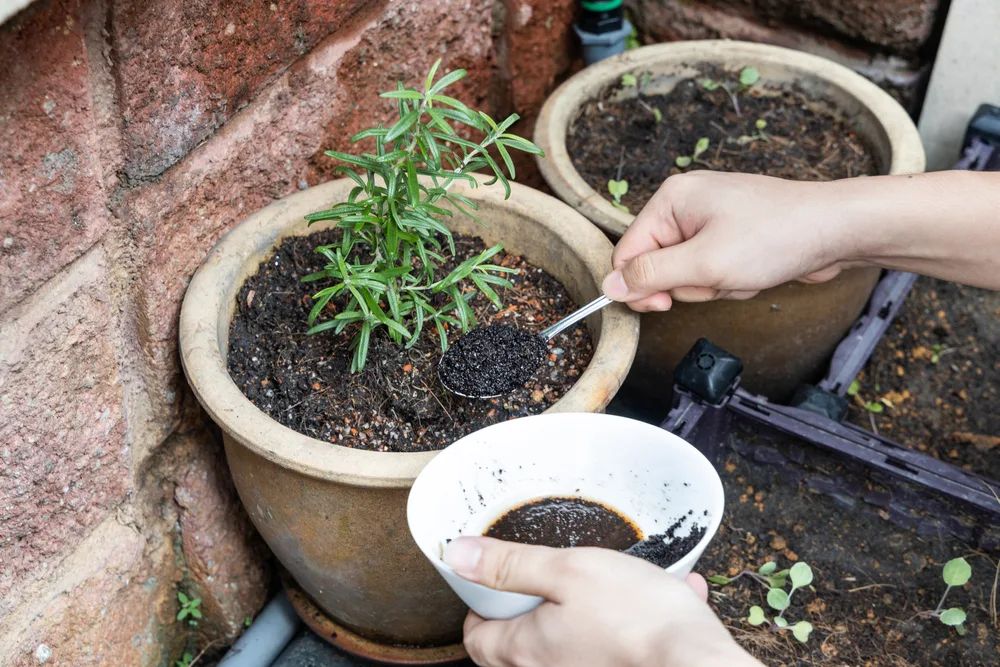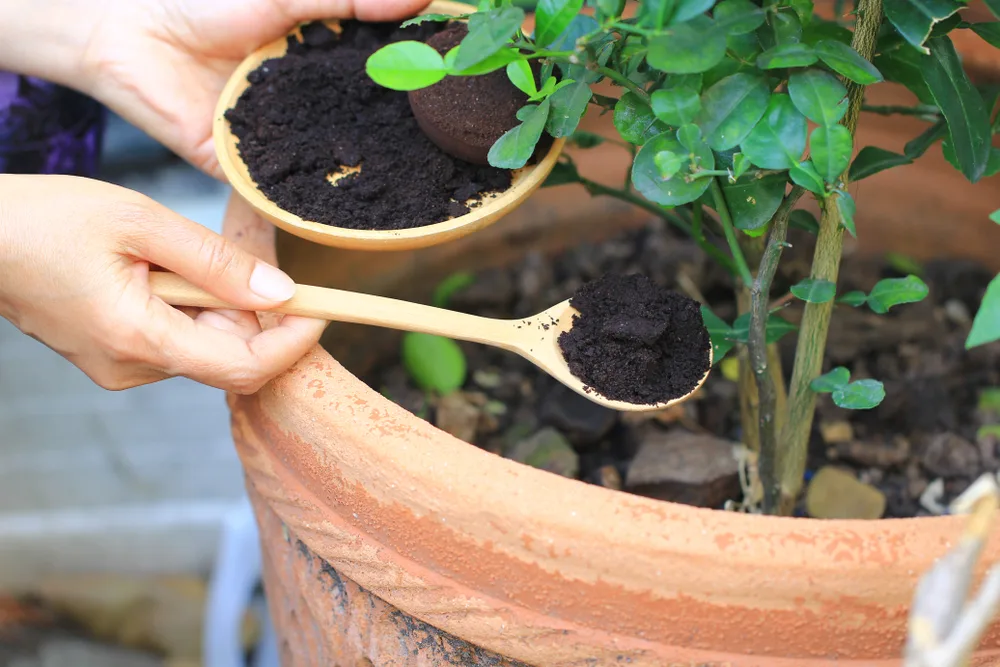Used coffee grounds from freshly brewed coffee can be very useful in your garden. You can still use them even if you’re not a coffee drinker.
Many coffee shops offer these grounds for free, neatly packed, and ready for pickup. This valuable waste is produced in large amounts daily.
Here are some exciting ways to reuse old coffee grounds to benefit your garden’s health, beauty, and vitality.

1. Compost Coffee Grounds
The easiest way to use coffee grounds is to add them to your compost pile along with other kitchen and garden waste.
Despite their brown color, coffee grounds are considered green waste, similar to grass clippings and garden weeds. In composting, you need both green and brown materials.
Greens add moisture, nitrogen, and other nutrients to the compost pile, while browns like dry leaves, sawdust, and straw provide carbon.
Browns also help aerate the mixture, preventing foul odors and absorbing excess moisture. Aim for a 50-50 balance between greens and browns in your compost pile.
Even after brewing, coffee grounds contain proteins, fatty acids, and carbohydrates that nourish the microorganisms, turning your organic waste into compost.
Adding grounds increases microbial activity, raising the compost’s internal temperature. This helps kill pathogenic bacteria, fungi, and weed seeds from your garden waste.
A concern with adding coffee grounds in large amounts is potential acidity. To counteract this, sprinkle lime or wood ash over the grounds and mix well.
If you burn wood, sprinkle damp grounds over the ashes before cleaning the grate to reduce dust and prepare the mixture for composting. Limit coffee grounds to about 10% of your compost pile by volume.
If you have a large supply of coffee grounds, composting alone might not suffice unless you have substantial yard waste. There are other ways to use this organic waste in your garden.
2. Improve Soil Texture
Adding a thick layer of coffee grounds to the soil can create an impermeable crust. However, they improve texture and organic content when mixed into the soil.
Coffee grounds are slightly acidic and break down slowly, releasing nitrogen and nutrients over time while keeping the soil loose and aerated. This is particularly helpful for heavy, alkaline clay soils.
Midwest and Western United States gardeners can benefit from adding coffee grounds to their soil. Spread an inch of coffee grounds in your garden and work it in with a rake. After covering a large area, use a rototiller to mix it deeply into the soil.
Coffee grounds can also benefit sandy soils. If you’re concerned about increasing soil acidity, test by adding grounds to a small area and checking the soil pH after a few weeks. Coffee grounds can vary in acidity, so results may differ.
Since tap water is usually alkaline, it can neutralize any acidity from coffee grounds. Soil organisms also play a role, so experimenting is the best way to see how coffee grounds affect your garden. You can always adjust soil acidity by adding wood ash or dolomite.
3. Feed Coffee Grounds to Worms
Coffee grounds are nutritious for garden earthworms and composting worms like red wigglers and nightcrawlers.
Worms transport coffee particles deep into the soil, and worm populations increase with regular coffee ground feedings. Worms are attracted to coffee grounds due to smell or taste.
You can add dry grounds to your vermicomposting bin after slightly dampening them, or you can include disposable coffee filters with the residue.
Worms enjoy shredded paper, so paper filters are a treat. Some people soak papers and cardboard in weak coffee to make them more appealing to worms.
Most vermicomposters bury small amounts of kitchen waste in different bin spots to avoid strong smells and flies, but coffee grounds tend to clump.
Mix them with kitchen waste, spread them evenly on the surface, and incorporate them with a fork. Grounds provide nutrition and grit, aiding worm digestion.
Be cautious of overfeeding worms with coffee grounds. Watch for smells like ammonia or vinegar, which indicate excess nitrogen or acidity.
Balance with carbon-rich materials like shredded paper or straw, and add ground eggshells to reduce acidity. Worms thrive in a pH range of 6 to 8.
4. Use Coffee Grounds for Acid-Loving Plants

Coffee grounds can benefit many other plants besides acid-loving ones. As they decompose, coffee grounds release nitrogen, one of the three key nutrients for plant growth. Leafy vegetables like spinach and cabbage thrive with extra nitrogen.
Coffee grounds also contain potassium, but their phosphorus isn’t readily available. Mixing crushed eggshells with coffee grounds helps provide a complete fertilizer with calcium and phosphorus.
Coffee grounds have enough magnesium, copper, and small amounts of manganese, calcium, zinc, and iron, although these are not all readily available.
Mixing carrot seeds with coffee grounds before planting can improve carrot harvests. This keeps seedlings safe from pests like root maggots and helps maintain well-aerated soil.
Coffee grounds also repel flies and keep the soil loose, making them a safe organic alternative to pesticides.
While sugar beet seeds germinate better in soil with coffee grounds, some plants, such as alfalfa and clovers, do not.
Avoid using coffee grounds around mustard greens, Japanese mustard, asparagus, and geraniums. Coffee liquid can negatively affect the germination of many seeds, but the reasons are unclear.
5. Protect Plants from Pathogens
Coffee grounds help protect plants from soil pathogens, including fungi like Pythium and Fusarium, that cause vegetable diseases. The exact mechanism is unclear, but beneficial microbes in decomposing grounds may suppress harmful organisms.
Brewing coffee doesn’t remove all nutrients from the grounds. They still contain lipids, proteins, and carbohydrates that support various microbes.
The fine texture of coffee grounds provides a large surface area for microbial action, potentially inhibiting harmful organisms.
Vegetables like spinach, cucumbers, beans, and tomatoes benefit from coffee grounds’ antimicrobial activity, which reduces rust and mildew diseases. Compost with just 5% coffee grounds offers this protection.
6. Make a Foliar Spray
Soak used coffee grounds in water overnight, then filter out the liquid to make an organic foliar spray. This spray provides nutrients and antimicrobial properties, repelling insects and caterpillars. The coffee smell or taste may deter critters.
Enhance the coffee liquid with compost tea for added benefits if you have a compost or worm bin.
7. Protect Plants from Slugs and Snails
Dry coffee grounds around plants may deter slugs and snails. Though not as sharp as diatomaceous earth, coffee grounds can still irritate these pests. Reapply as needed as the grounds break down.
8. Use Coffee Grounds as Mulch
You can use coffee grounds as mulch, but not alone. They tend to compact, impeding drainage and air circulation. Mix coffee grounds with larger particulate mulches for best results.
